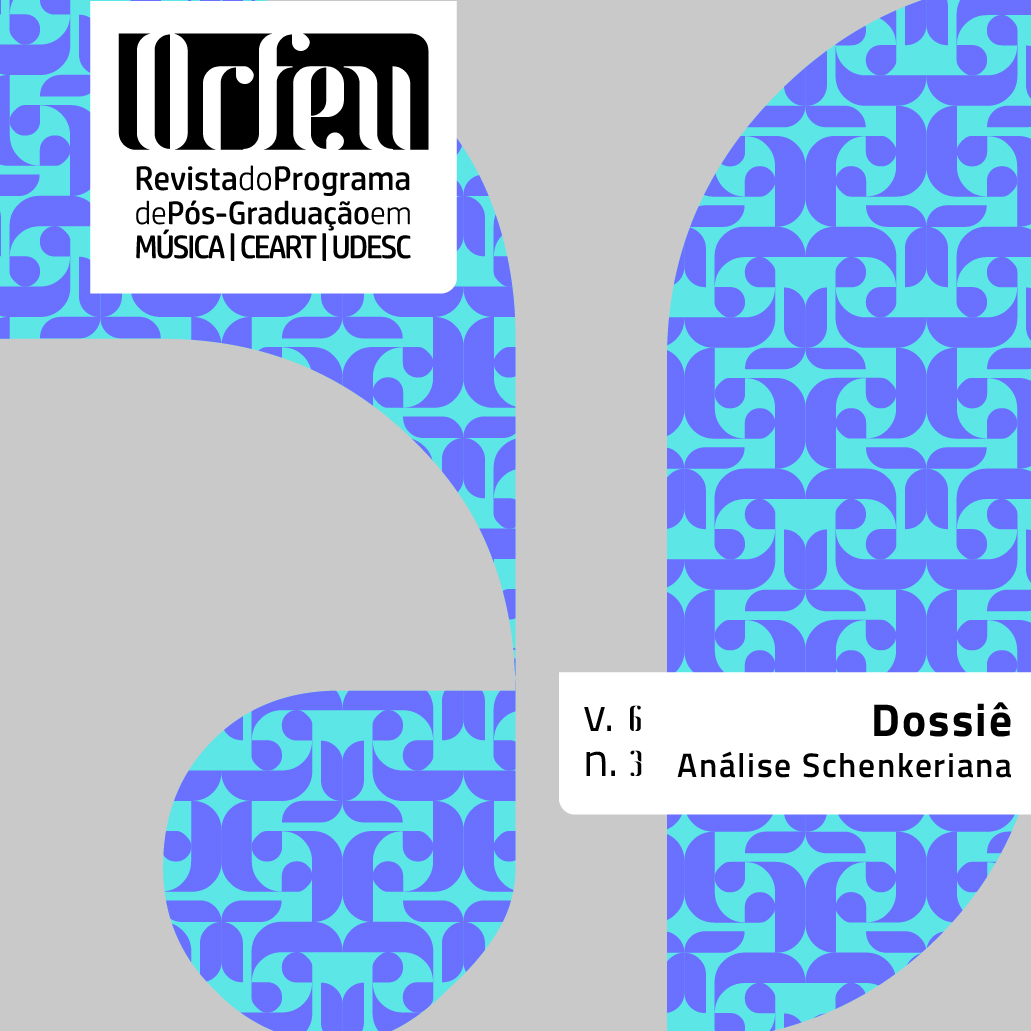Prolongation
DOI:
https://doi.org/10.5965/2525530406032021109Parole chiave:
Prolongation, Auskomponierung, time span, depth, organicismAbstract
The article evidences and documents the differences in meaning between the English term “prolongation”, the German Prolongation, and Schenker’s own understanding of the term. It stresses that, for Schenker, the word describes the organic relation from Ursatz to foreground, a relation in the “depth” of the work, while in English it denotes the extension in time of a harmonic or melodic event. The English understanding of “prolongation” is not illegitimate, but it hides a dimension of Schenker’s understanding.
Downloads
Riferimenti bibliografici
Berry, David Carson (2005). “Victor Vaughn Lytle and the Early Proselytism of Schenkerian Ideas in the U.S.” Journal of Schenkerian Studies 1, pp. 92–117.
Cook, Nicholas (2007). The Schenker Project. Culture, Race, and Music Theory in Fin-desiècle Vienna. Oxford, New York, Oxford University Press.
Dubiel, Joseph (1990). “When You are a Beethoven: Kinds of Rules in Schenker’s Counterpoint.” Journal of Music Theory, 34/ii, pp. 291-340.
Forte, Allen, and Steven E. Gilbert (1982). Introduction to Schenkerian Analysis. New York, Norton.
Goldenberg, Yosef (2008). Prolongation of Seventh Chords in Tonal Music. Lewinston, NY, Mellen Press. Vol. I, Text; vol. 2, Examples.
Grimm, Jakob and Wilhelm (1889). Das Deutsche Wörterbuch, vol. VII, N, O, P, Q. Leipzig, S. Hirzel. Online, http://dwb.uni-trier.de/de/ (last checked 14/03/2021).
Katz, Adele T. (1935). “Heinrich Schenker’s Method of Analysis.” The Musical Quarterly 21/3, pp. 311-329.
Katz, Adele T. (1945). Challenge to Musical Tradition. A New Concept of Tonality. Knopf, New York.
Koslovsky, John Ch. (2009). From Sinn und Wesen to Structural Hearing: The Development of Felix Salzer’s Ideas in Interwar Vienna and Their Transmission in Postwar United States. PhD Thesis, University of Rochester.
Krünitz, D. Johann Georg (1811). Oekonomische Encyklopädie oder allgemeines System der Staats- Stadt- Haus- u. Landwirthschaft, vol. 117, Berlin, J. Pauli, s.v. Prolongation. Online: http://www.kruenitz1.uni-trier.de/xxx/p/kp07807.htm (last checked 14/03/2021).
Lerdahl, Fred, and Ray Jackendoff (1983). A Generative Theory of Tonal Music. Cambridge, Mass., The MIT Press.
Lytle, Victor Vaughn (1931). “Music Composition of the Present: An Analysis of the Trend of Composition Based on the Proved Achievement of the Greatest Masters of Past Centuries.” The American Organist 14/11, pp. 661-666, quoted in Berry (2005).
Meeùs, Nicolas (2015). “Formenlehre in der freie Satz: A Transformational Theory.” Schenker’s Formenlehre, Rivista di Analisi e Teoria Musicale XXI/2, pp. 99-113.
Meißner, Johann Karl (1836-1837). Codex der europäischen Wechsel-Rechte oder Sammlung der heutzutage in Europa geltenden Wechsel-Gesetze. Nürnberg, J. L. Schrag. Vol. 1, 1836, Die deutschen Wechselgesetze. Vol. 2, 1837, Die Wechselgesetze außerhalb der deutschen Bundesstaaten.
Meyer, Hermann Julius (1850). Meyer’s Großes Konversationslexicon, Zweite Abteilung, vol. 4. Hildburghausen, Verlag des Bibliographischen Instituts.
Morgan, Robert P. (1976). “Dissonant Prolongation: Theoretical and Compositional Precedents.” Journal of Music Theory 20/1, pp. 49-91.
Salzer, Felix (1952). Structural Hearing. Tonal Coherence in Music. 2 vols., New York, Boni.
Schenker, Heinrich (1906). Harmonielehre. Stuttgart, Berlin, Cotta. Harmony (1954), O.
Jonas ed., E. Mann Borghese transl. Chicago, The University of Chicago Press.
––––– (1910). Kontrapunkt 1. Wien, Universal. Counterpoint I (1987), J. Rothgeb and J. Thym transl. New York, Schirmer.
––––– (1922). Kontrapunkt 2. Wien, Universal. Counterpoint II (1987), J. Rothgeb and J. Thym transl. New York, Schirmer.
––––– (1923a). “J. S. Bach: Zwölf kleine Präludien, Nr. 3 [BWV 999].” Der Tonwille 5, pp. -4. Der Tonwille I (2004), J. Dubiel transl., pp. 175-176.
––––– (1923b). “J. S. Bach: Zwölf kleine Präludien, Nr. 5 [BWV 926].” Der Tonwille 5, pp. -9. Der Tonwille I (2004), J. Dubiel transl., pp. 180-181.
––––– (1923c). “Beethoven: V. Sinfonie (1. Fortsetzung).” Der Tonwille 5, pp. 10-42. Der Tonwille I (2004), W. Drabkin transl., pp. 182-209.
––––– 1923d). “Vermischtes.” Der Tonwille 5, pp. 43-57. Der Tonwille I (2004), J. Lubben transl., pp. 210-225.
––––– (1924). “Erläuterungen.” Der Tonwille 8/9, pp. 49-51. This text was published also in Der Tonwille 10 (1924), pp. 40-42 and in Das Meisterwerk in der Musik 1 (1925), pp. 203-, and 2 (1926), pp. 195-197.
––––– (1925). “Domenico Scarlatti. Sonate für Klavier D-Moll.” Das Meisterwerk in der Musik 1, pp. 125-137. The Masterwork in Music I (1994), I. Bent transl., pp. 67-74.
––––– (1930). “Rameau oder Beethoven? Erstarrung oder geistiges Leben in der Musik?” Das Meisterwerk in der Musik 3, pp. 9-24. The Masterwork in Music III (1994), I. Bent transl., pp. 1-9.
––––– (1935). Der freie Satz. Vienna, Universal. 2d edition, O. Jonas ed., 1956. Free Composition, E. Oster transl. of the 2d edition, New York and London, Longman, 1979.
L’Écriture libre, N. Meeùs transl. of the 2d edition, Liège, Mardaga, 1993.
Snarrenberg, Robert (1996). “The Art of Translating Schenker: A Commentary on The Masterwork in Music, Vol. 1”. Music Analysis 15/2-3, pp. 301-342.
Väisälä, Olli (2004). Prolongation in Early Post-Tonal Music. Studia Musica 23. Helsinki, Sibelius Academy.
Weigand, Fr. L. K. (1910). Deutsches Wörterbuch, 5th ed., H. Hirt ed., vol. II, Gießen, A. Töpelmann.
Downloads
Pubblicato
Come citare
Fascicolo
Sezione
Licenza
Copyright (c) 2021 Nicolas Meeùs

TQuesto lavoro è fornito con la licenza Creative Commons Attribuzione 4.0 Internazionale.






